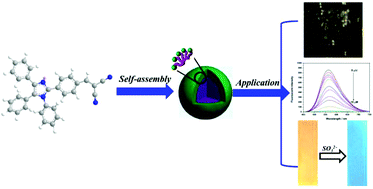A self-assembled fluorescent organic nanoprobe and its application for sulfite detection in food samples and living systems†
Abstract
Sulfur dioxide (SO2) is a widely distributed air pollutant, and humans can easily be exposed to sulfite by inhaling SO2, thus inducing respiratory responses and diseases. Hence, to develop a rapid, sensitive and selective method for detection of sulfites is of great importance. Herein, we designed and synthesized a novel tetraphenyl imidazole compound TIBM with aggregation-induced emission enhancement (AIEE). TIBM can self-assemble into well-organized nanoparticles and is reported as an excellent probe for detection of sulfite with high selectivity and sensitivity. The nanoprobe performed very well for the detection of sulfite with an ultrafast detection time (15 s) and an ultralow detection limit (7.4 nM), which is superior to most of the reported probes. Moreover, the nanoprobe was successfully used to detect sulfite in food samples with a favorable accuracy. In addition, we developed paper-based devices for point-of-care detection of sulfite with naked eyes. Furthermore, due to its high water solubility, cell membrane permeability and good biocompatibility, the nanoproboe was further applied to detect sulfite in living systems. This study may offer some helpful insights for designing other AIE-based fluorescent nanosensors for various analytes.



 Please wait while we load your content...
Please wait while we load your content...